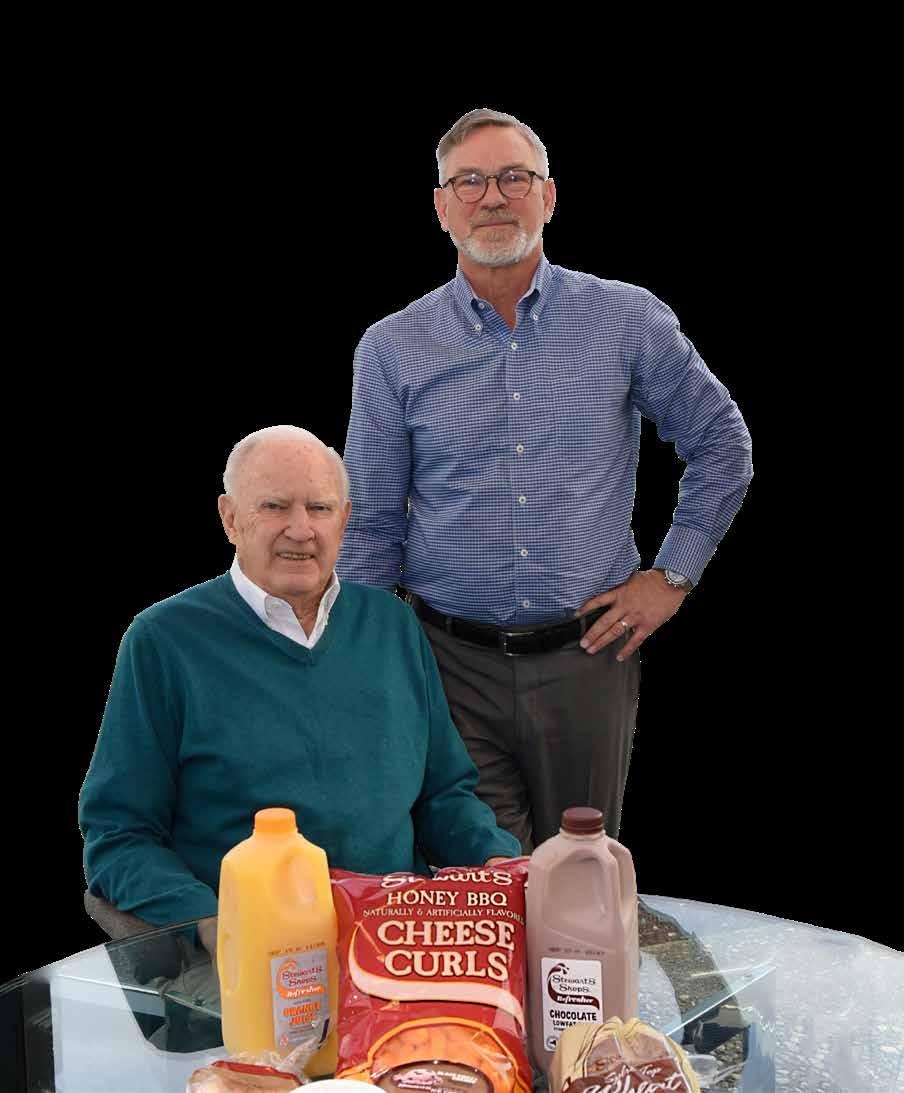








EDITOR
Chad Beatty, Publisher


CBeatty@saratogapublishing.com
As the third quarter comes to a close and the fourth quarter begins, we find ourselves wondering where the time has gone and what the future has in store for us.
While we see light at the end of the tunnel with the pandemic coming to a close, we also see interest rates rising far too fast for our comfort, an embattled stock market struggling against an onslaught of negative indicators, and an everchanging labor market forcing businesses to scramble.
I can’t help but ask if this is an assault on capitalism by law makers and politicians, or just bad timing combined with poor decisions. As Bill Dake suggests in our ‘Multigenerational Businesses’ story, the similarities between reallife and Ayn Rands ‘Atlas Shrugged’ are a little frightening!
Michael Nelson, Publisher
Info@spacitydigital.com
SaratogaBusinessReport.com

But, without adversity there is no progress; for without darkness there is no light. Tough times create strong leaders, and in this issue we introduce you to a few of those leaders as well as a few thriving industries that are capitalizing on change.
So, flip the pages and get to know these power players, and remember, the main thing is Never, Never quit. You are building the future!
Lastly, we want to send a big thank you to our advertisers, for without them we wouldn’t be able to offer you this magazine free of charge. Please keep them in mind as you conduct business and keep Saratoga County moving.
Chad Beatty
MAGAZINE DESIGNER
Kacie Cotter-Sacala

Kelsey Sherman Kelly Schoonbeck
Tristan Amzallag
Kelly M. Curro, Esq.
Jordan Dunn
Dan Lindquist
Tyler A. McNeil
Tyler Murray Mike Piekarski
Megin Potter
Katie Tansey
Kacie Cotter-Sacala
Thomas Dimopoulos Super Source Media Studios
2254 Route 50 South Saratoga Springs, NY 12866 518-581-2480
saratogaTODAYnewspaper.com SpaCityDigital.com
Saratoga Business Report magazine is brought to you by Spa City Digital. Spa City Digital shall make every effort to avoid errors and omissions but disclaims any responsibility should they occur. No part of this publication may be reproduced, stored in a retrieval system, or transmitted in any form or by any means without prior written consent of the publisher. Copyright © 2022. Saratoga Business Report.
- Chad & Michael
“The secret of change is to focus all of your energy, not on fighting the old, but on building the new.”

Tool Box
News:

Ups, & Downs of
Leads:
Businesses:
Dake Family
Electric Vehicle (EV) Revolution
Smith Taking Airosmith
New Heights
Green New Market
Eagle:
Assets
Deep Dive Into Concord Pools
in Saratoga County
Business In New York?

You Need to Know…
Gaming Titan Returns

Halfmoon Studio
Center: Driving Revenue in Saratoga County


The Saratoga County Chamber of Commerce offers entrepreneurs and small businesses: FREE in-person and virtual business counseling; free talent recruitment services; access to the only Saratoga County focused monthly economic update; boosted posts on our largest in the region social networks to amplify local news, products, services and job openings; health insurance; and local networking. 518-584-3255 | Saratoga.org
CAPITAL REGION CHAMBER OF COMMERCE

Build connections, gain knowledge, generate business, and be part of our collective influence for businesses and people to thrive. The Chamber helps build a strong community by connecting our members to people, business and issues important to business success. Through the Chamber, you and your business are engaged in initiatives that move us toward a successful future. 518-431-1400 | CapitalRegionChamber.com
BUSINESS COUNCIL OF NEW YORK STATE


The leading business organization in New York State, representing the interests of large and small firms throughout the state. 111 Washington Avenue, Suite 400, Albany, NY 12210 | 518-465-7511 | bcnys.org
BUSINESS MENTOR NY
For entrepreneurs, turning a passion into a business is the ultimate dream. But that dream doesn’t come easily. Fortunately, entrepreneurs don’t have to go it alone. Business Mentor NY is a free, easy-to-use social network that allows entrepreneurs and volunteer business mentors to connect so they can solve problems and build businesses together.
BMNY.micromentor.org | Support.businessmentor@esd.ny.gov

EMPIRE STATE DEVELOPMENT
New York’s chief economic development agency. Through the use of loans, grants, tax credits and other forms of financial assistance, Empire State Development strives to enhance private business investment and growth to spur job creation and support prosperous communities across New York State. 625 Broadway, Albany, NY 12207 | 518-292-5100
NEW YORK STATE CONTRACT REPORTER

The New York State Contract Reporter is an online publication of procurement opportunities with New York State agencies, authorities, public benefit corporations, and many municipalities. The Contract Reporter is an essential tool for selling your product/ services to New York State government. | NYSCR.ny.gov
NEW YORK STATE DEPARTMENT OF LABOR 518-457-9000 | DOL.ny.gov
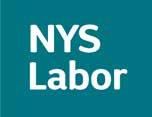
NEW YORK STATE DIRECTORY OF SMALL BUSINESS PROGRAMS



Helping NYS business build back. Find out more about Business Pandemic Recovery Initiative programs - including $800 million in state funding for small businesses - and about rental assistance for tenants. | ESD.ny.gov/business-pandemic-recovery-initiative
NEW YORK STATE ENERGY RESEARCH & DEVELOPMENT AUTHORITY (NYSERDA) NYSERDA offers objective information and analysis, innovative programs, technical expertise, and support to help New Yorkers increase energy efficiency, save money, use renewable energy, and reduce reliance on fossil fuels. 518-862-1090 | NYSERDA.ny.gov
NEW YORK STATE MINORITY & WOMEN OWNED BUSINESS ENTERPRISE ESD.ny.gov/mwbe-new-certification
Access more than 15 small business loan programs custom-fit to your needs, including SBA 504, SBA 7(a), and SBA Microloans. You’ll work one-on-one with a lender dedicated to understanding your business and your borrowing needs. 800-923-2504 | PursuitLending.com
38 local SCORE volunteer mentors help small businesses and entrepreneurs start and grow their businesses. SCORE is a nonprofit and all services are free and confidential. Contact: Richard Sellers | richard.sellers@scorevolunteer.org

Many people, including former Fed Chair Alan Greenspan, believed Bitcoin would not survive over the last 10 years. He declared it dead or worthless twice; once at $1,147.25 per btc (Bitcoin) and again at $13,708.99 per btc. Jamie Dimon, the CEO of JPMorgan, also declared Bitcoin dead or worthless half a dozen times, the first was at $408.74 per btc and the last time he did it, the price was $57,490.31 per btc. In fact, bitcoinisdead.org has collected all the public declarations of Bitcoin’s death since its inception and they report over 380 cases of economic leaders, politicians and journalists making the same declarations. Yet, here we are, sitting at $22,000 per btc at the time of writing. Bitcoin is still very much alive, and not only is it alive but it is resilient and thriving. A price of $22,000 per btc is higher than the highest point it reached in 2017 when it hit $19,000 per btc. While this is good news and a sign of growth in the macro view, we shouldn’t easily dismiss the recent events in the crypto market. In November of 2021 Bitcoin hit an unprecedented $69,000 per btc and Ethereum hit $4,644 per eth, many new investors saw an exploding sector and due to an abundance of cash, coupled with a pandemic fueled need to spend it, they poured into the crypto space creating a massive bull run and minting many new millionaires along the way; however, both

have come crashing down some 60% since then, which in stock market terms is a full blown depression. This has left many newcomers feeling like Bitcoin was the worst investment they have ever made. I’m here to tell you it wasn’t.
What if I told you that the 2021 bull run was actually predicted and could even be “counted on”? In fact 2021 was the third in a predicted series of bull runs during Bitcoin’s history, and after each bull run we’ve experienced a “crypto winter” like the one we are in now. These bull runs have a correlation to the way Bitcoin works as a technology and because Bitcoin has been coded to execute a certain way, those executions allow us to map out the price trajectory of Bitcoin. This all seems a little too good to be true since if you can predict bull runs then someone could make a lot of money, and in fact people have!
To understand what’s going on, and how we can predict these bull runs, we need to get a little technical about how Bitcoin works. Bitcoin is capped at 21 million total coins, but they haven’t all been mined yet. Satoshi (Satoshi Nakamoto is the name used by the presumed person or persons who developed bitcoin) was a smart guy and knew not to release all the coins at once, which would allow malicious actors to simply acquire all of them and render the network useless. Instead, Satoshi coded the network to release the coins at a variable pace. He wanted to release many coins at first and the remaining coins slower over a long period of time. It has been determined that the last Bitcoins will be mined in 2140. This “slow burn” allowed users enough coins to start working with the technology to develop new applications, but also prevented monopolizing of the network.

Miners are the network participants that mint new Bitcoin; they can then sell that Bitcoin to cover their bills and pay themselves for their work. When Bitcoin was released, miners were rewarded with 50 new Bitcoin every 10 minutes, however 4 years later a pre-programmed event happened where the number of newly minted Bitcoin was cut in half. The reward for miners went from 50 to 25. This event is called “The Halving”. Roughly six months after the first halving, we saw Bitcoin’s first bull run to $1200/btc, up from $35/btc. That’s a 3400% rise over a period of six months. Shortly after the run the price crashed 90% and Bitcoin was declared dead many times throughout 2014 and 2015. In fact Bitcoin was the second worst performing currency of those years, beaten only by the Ruble. Bitcoin was, in fact, not dead, instead it landed at $195/btc which was higher than where it had started at the bull run. That’s progress.
Four years after the first halving event, as coded into the technology, Bitcoin had its second halving and the reward of new Bitcoin fell from 25btc to 12.5btc. This led to Bitcoin’s second market bull run, this time climbing all the way to $19,000 in December of 2017. That price also came crashing down through 2018 to a bottom of $3400/btc in March 2019; a drop of 75%. Once gain Bitcoin was declared dead and many crypto projects went bankrupt or were abandoned. Yet again the naysayers missed the big picture and failed to see that $3,400 was progress as it was the highest low Bitcoin had ever seen.
Once again, in 2021, Bitcoin experienced another Halving event, this time reducing the supply of new Bitcoin from 12.5btc to 6.25bt. As expected, this once again led to another bull run, this time taking Bitcoin all the way to $69,000 in November of 2021. Following that high point, we once again see a drop of 60% back down to $22,000 in 2022, which brings us to today. Technically Bitcoin did drop a little further to $17,000 but it did not hold that low for long and bounce right back to a predicted $22,000 which is higher than the previous bull run high of $19,000.

As in previous cycles, Bitcoin once again made significant progress; not only are the lows still higher than previous highs, but we also see that the percentage drop after each bull run is smaller.

Obviously, there is a pattern here and it is clearly driven by these halving events, but why? It’s simple supply and demand economics. There are only about 12% of all Bitcoin actively traded on the open market, the rest tend to be held in wallets by long term investors, or as liquidity for crypto businesses. This means that the amount of Bitcoin out there for grabs is small and when a halving event occurs the amount of new Bitcoin that can enter the market gets reduced by half, causing a major disruption in supply which in turn jolts the market into these bull runs. By comparison imagine what would happen to the price of gas if oil supply was suddenly cut in half, we would see a similar jolt in oil prices.
The Bitcoin market cycle can be broken down into 4 phases which begin during the period of contraction right after a bull run:
The first phase is known as Accumulation and it occurs once the price has hit its bottom and begins to turn upward again. Investors identify the maximum money making opportunity during this phase and fewer Bitcoin circulate.


The second phase is known as Continuation, during this phase the price continues to move up but slowly at first. The halving event occurs during this phase and helps to propel the price into the next phase.
The third phase is known as Parabolic where the halving event, coupled with exuberance from investors pushes the price to a new all time high (known as ATH). This phase is extremely volatile, as we saw in 2021.
The fourth and final stage is known as Correction where the exuberance dies and the market sees a major correction. During this time there is a lot of capitulation and bankruptcies within the industry, money is lost and many bad bets are called in. But, ultimately, the strong survive and help to grow the market each time.
Source: CalebAndBrown.com/blog/bitcoins-market-cycle
If we use the same model to look into the future we start to see numbers like $150,000/btc by December 2024 after the halving in March, and $350,000/btc to $450,000 in 2028 and even $1,000,000/btc in 2032. The halving in 2032 will cause new Bitcoin mined to go from 1.52 to 0.78 per block. That’s a very small amount of Bitcoin compared to the 6.25btc mined today. That drop in available btc stock will force the price into these larger numbers as Bitcoin matures and demand either stays the same or rises.
As you can see, this 2021 bull run was very much in line with past Bitcoin behavior and understanding the forces behind these bull runs will allow you, the investor, to better navigate the Bitcoin and Crypto market places. If you invested in Bitcoin at the high, I hope this article can bring you some reassurance about the bet you made for the future. If you’ve been waiting on the side lines for a good time to buy Bitcoin, we’ve just entered the Accumulation phase, which is historically the best time to buy in.
While I spent a lot of time analyzing the Bitcoin market cycle in this article, it’s important to note that Bitcoin is the king of crypto at the moment and where it leads, all the other cryptos follow. I don’t believe this will hold true forever and much like the stock market, other crypto projects such as Ethereum, Cardano and Solana will break away from Bitcoin’s grip and start to form their own market patterns, but that day has not come yet.
I also want to note that this Bitcoin pattern won’t last forever, as the amount of new Bitcoin that is mined gets reduced, the price volatility will calm down and eventually market bull runs followed by crashes will smooth out, paving the way for Bitcoin to become an excellent store of value, a hedge against volatility and a steady medium for currency exchange.

New leads are the life-blood of the sales cycle, but tracking them down can be time consuming and costly.

While these may not be the ‘Glengarry leads’, they will get your team on their way to landing new business.

Just remember,
Be
Awakened Tonics LLC
Heidi Radko 198 Northern Pines Road, Gansevoort, NY 12831
Sunshine Pack Walking LLC
Karissa DiSofi 707 Freeman Court, Gansevoort, NY 12831
Precision & Design Tile Company 24 Greenlea Drive, Clifton Park NY 12065
Super Source Media Studios LLC Lindsey Fish 3065 NY-50 Box 3, Saratoga Springs NY 12866
Monahan Equipment LLC 35 Second Street, South Glens Falls, NY 12803
K&T Farms LLC 4 Craw Lane, Gansevoort NY 12831
Fleischman B&B, LLC 137 2nd Street, Apt #2, Waterford, NY 12188
Self Direction Partners, LLC PO Box 381 Gansevoort, NY 12831
Southern Adirondack Midwifery PLLC
Hannah Gregory 3 Hemphill Place #112, Ballston Spa NY 12020
Hudson Storage, LLC Ryan Blass
9 Morris Lane, Clifton Park, New York 12065
RBW CREATIONS, LLC 277 County Route 68, Saratoga Springs, NY 12866
Eteannette Seymour LLC 10 Underwood Drive, Saratoga Springs, New York 12866
Ali Blake Photography, LLC
3 Sophia Marie Lane, Malta, NY 12020
Loves Colors LLC 20 Conver Drive, Saratoga Springs, NY 12866
Deborah Condon, 26 Commons Blvd., Halfmoon, NY 12065
Lansing U, Christopher Lansing, 11 Canyon Crossing, Greenfield Center, NY 12833
Andrew Farina, 2319 Huntridge Dr., Clifton Park, NY 12065
2 Christinamarie Dr., Clifton Park, NY 12065
Taylor Czesnik, 21 Stoney Creek Dr., Clifton Park, NY 12065
Pine Knolls Alliance Church
614 Gansevoort Rd., South Glens Falls, NY 12803
SkyTech MSP
Christopher Payant, 122 Broad St., Schuylerville, NY 12871
Dave’s Property Management, David Lavertue, 326 Atomic Project Rd., Lot 17, Ballston Spa, NY 12020
Bloom Brokerage
Nicole Russell, 5 Merchant Lane, Burnt Hills, NY 12027
Reimann Ranch
Christal Reimann, 491 Finley Rd., Ballston Spa, NY 12020
Sweet Betty’s, Jennifer Wagner and Robert Wagner Jr.,
49 Wilson Ave., South Glens Falls, NY 12803
Christina Simmons, 976 Benedict Rd., Ballston Lake, NY 12019
Sarah Paruolo, 1289 Saratoga Rd., Apt 1 Gansevoort, NY 12831
Chelsea Piersol, 17 Pine Rd., South Glens Falls, 12803
Center for Clear Hearing, Kate Kawola-McAdam, 952 Route 146, Ste. #2, Clifton Park, NY 12065
Bare Hill CBD
Randell Larock, 1306 Saratoga Rd. #4, Gansevoort, NY 12831
509 Hand Works
Nicole Shrimpton, 177 W. North St. Ballston Spa, NY 12020
Art by Carolee, 19 Tipperary Way, Ballston Lake, NY 12019
Headstone Restoration
Devin Hazelton, 50 Hatchery Rd., Gansevoort, NY 12831
Soulful Living For You
Elaine Visconti, 2B Scottish Glen, Ballston Lake, NY 12019
Saratoga R/C & More
Mark Rabideau, 2006 St. Paul Dr. Ballston Spa, NY 12020
Knead To Relax Massage Therapy
800 Route 146, Suite 345, Clifton Park, NY 12065

Saratoga’s Finest Handyman, Renovations and Landscaping, Matthew Des Jardins, 38 Madison St., Saratoga Springs, NY 12866
Chaellaesthetics
Michaella Lum, 131 Saratoga Ave., South Glens Falls, NY 12813
Welcome to our new quarterly feature on multi-generational businesses. We begin with a family, whose business literally keeps us all running. I am of course speaking of the Dake Family and Stewart’s Shops.

Like all dairy farmers, Percy (Bill Dake’s Uncle) and CV (Bill Dake’s Father) didn’t feel they were getting paid enough for their milk. So, they decided to make butter and ice cream. They had the milk for it, and they also happened to have a bright red Model T Ford truck, recalls Bill.
The Dake brothers capitalized on the combination of mechanical refrigeration and transportation to expand their market. By the end of their first year, Percy and CV had sold 4,000 gallons of Dake’s Delicious Ice Cream, delivering to customers in Saratoga, Ballston Spa, Schenectady, Albany and Troy.
By 1929, Dake’s Delicious Ice Cream had become a regional household name and the brothers’ business expanded from 4,000 gallons in their first year to a whopping 100,000 gallons.
Fast forward 2 decades.
After a series of events, business moves, and possibly a little serendipity, in 1945 the Dake brothers purchased Stewart’s Ice Cream Company from Don Stewart and kept the Stewart’s name. Because NY state licensing laws limited which townships a dairy could sell their milk in, purchasing the Stewart’s dairy allowed the Dakes to expand their area of operation.
Stewart’s Shops was born.
Q:What is your company ethos that helps to drive the success?
Bill: Stewart’s is a sharing company with 40% ownership by our Partners through an ESOP, and also sharing with our customers and their communities with $9 million of annual contributions from Stewart’s and related family foundations. We also share more than most between departments, shops, and Partners which why we can afford to do the first two.
Gary: After sharing, I think it’s CPR – the Confidence to Pursue Reality. Bill has that on a sign on his credenza. Accepting the
truth and sharing between departments rather than having friction, rather than trying to wish problems away is a huge part of what we do.
Q:Share some significant milestones that stand out in the history of Stewart’s Shops?
Bill: In the early ‘80s I overruled the rest of the management team’s objections and mandated that we were going to let customers make their own coffee. The District Managers were sure that customers would break pots and create a mess. Our customers loved it and we
really became a disruptor in the coffee business as one of the first places in the area to allow people to make their own coffee. Customers ended up breaking fewer pots than employees do. It’s the reason we’re so dominant in the coffee business today.
Gary: Another important tipping point was getting into the gasoline business in the late ‘70s. Bill had been buying obsolete gas stations from the oil companies and finally Mobil decided they wouldn’t sell the Hudson location to him if we didn’t sell gas. We bought the site, sold gas, and haven’t looked back.

Q:Who had the vision for, and when was the ice cream bar added to the stores?
Bill: You’ve got it backwards! We started as ice cream shops and added the rest of the store. First we added milk, which we were selling elsewhere, when we successfully challenged New York State for the right to sell our milk in our own shops. After that we added some groceries, and eventually added more traditional convenience store items evolving into what you see today.
Q:I know vertical integration has been an important piece of your strategy. Can you expand on that?
Gary: We exercise a tremendous amount of control by manufacturing and distributing a large portion of our product line. 85% of everything in the store came on our own trucks from our warehouse. This was particularly important during the challenges of COVID. We also don’t get caught trading off quality when cost pressures hit.
Bill: More than just the products, we support the shops in personnel, accounting, marketing, and facility issues. It comes back to the sharing we talked about earlier.
Q:One thing that makes Stewart’s stand out is your ESOP plan. Tell us about that, and how it has helped to shape your team? Any standout success stories?

Bill: My brother and I started a profit sharing plan back in the ‘70s. We really believed that sharing the ownership of the company, and the rewards of its success, with the employees, more than the grandchildren, would make the business more successful. That first year our contribution to the plan was $150,000. Last year the contribution to the ESOP was over $20 million. Much of that growth is because the front-line employees, the management team, and the family all had the same goal – to grow the company. We converted to a full ESOP in 2001.
Gary: I came up through the manufacturing side of the business and it felt so good to watch guys I’d known most of my life who joined the company right out of high school or the service work hard and retire with over $1 million dollars without contributing a dime of their own money. It’s a gift to be able to help those hard-working people maximize the fruits of their efforts.
Bill: I bought a lot of old gasoline locations in the ‘70s, ‘80s, and ‘90s as the major oil companies decided the old two-bay garage with two pumps out front no longer fit their model. These were great locations but were simply too small for what they wanted to do. We got prime locations with room for parking to bring people into the stores.
Gary: We are a bit unusual in the industry in that we own nearly all of our real estate. Not paying rent to outside parties adds to the bottom line and gives us a tremendous amount of control. We have been buying adjacent parcels and expanding shops pretty regularly over the last several years. Those have been very profitable rebuilds.
a company, and as business leaders, how do you balance civic responsibility vs. profitability?
Gary: I don’t see them in conflict with each other. Strong communities are a good place to do business. We also get a tremendous marketing value from the reputation of giving back to our communities. When we’re not perfect, we often get the benefit of the doubt because we are known to be fair and generous, as opposed to being a big, evil corporation.
Bill: This all goes back to the concept of being a sharing company I spoke about earlier.
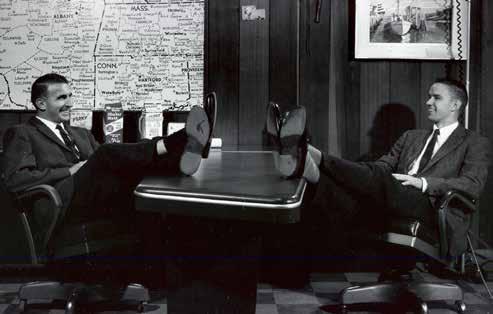
Our emphasis on sharing sounds a bit philosophical, but it really is meaningful and effective. - Bill DakeBill and Gary Dake. Charles S. Dake (left) and William P. Dake (Bill) (right)
Q:I would imagine that coffee is one of your biggest single revenue line items. Am I correct? What are your top 3?
Gary: Actually, coffee comes in third. Cold beverages are number one, prepared foods are second, and coffee is third.
Bill: We have become the diner in many small towns, and even in some cities. Our variety of products make us the perfect place to eat. We like to say we have 100 ways to get you un-thirsty.
Q:What do you see as the biggest growth opportunities for Saratoga County in the next decade?
Bill: People often fail to realize how balanced the economy of Saratoga is. We’re a resort community, a college town, a bedroom community, and have a strong industrial base, even preceding Global Foundries. We also tend to benefit from the fact that we draw employees from some surrounding counties which have fewer job opportunities but are nice places to live.
Q:When owners/CEO’s make the decision to keep management of their company within the family, I imagine there are many stumbling blocks to avoid. Stewart’s Shops has successfully navigated through multiple generations. What is

the best advice you can offer families preparing for that transition?
Gary: We all worked for the company as kids. We have a rule that you have to work somewhere else for at least three years before coming back to the company. That’s a great practice that we would encourage everyone to follow.
Bill: We’ve had several family members come back to work here only to find out that it wasn’t for them. No one should work in their family business out of a feeling of obligation.
Q:Many entrepreneurs tap into the brain power of business leaders who have come before them. Is there a specific person, or two, who have impacted your outlook on leadership? If so, who are they and do you have a favorite quote?
Bill: We can’t think of any specific individuals that influenced our thinking, but our family was full of stories, phrases, and key words that were constantly creating a philosophy of how to properly run a business and live life.
Gary: I also believe that there’s something to learn from anyone. Everyone knows something you don’t. Having enough respect to be willing to learn from anyone, regardless of their station in life is paramount.
Q: Total locations by 2025?
A: Maybe 375. We don’t set artificial targets – we take what the market offers.
Q: Favorite ice cream flavor?
Bill: Espresso Therapy. Gary: Chocolate Peanut Butter Cup.
Q: Cups of Stewart’s coffee per day?
A: Almost 100,000
Q: Books on your bedside table?
A: While it’s not on either of our bedside tables right now, everyone should read or re-read Atlas Shrugged. The parallels are a little frightening today!
Q: Favorite Saratoga restaurant?
A: There are too many good choices to pick just one. We are so fortunate to have so many good options.

No matter what your beliefs, for better or for worse, a change to the car industry is coming; The question is - is our county ready for what’s next?
Saratoga and the greater Capital Region is used to tradition. Champions of small-town life, extreme loyalists to its summer traditions like the Saratoga Racetrack or strolls down picturesque Broadway: those that live there know what it means to live an “upstate lifestyle.” So how will a radical change like the introduction of Electric Vehicles to our world’s society alter the traditionalists of Saratoga County? Saratoga Business Report spoke with a few local entities to discuss the realities of EV and the presence that EV will have both in our world, and in our local community in the years to come.
Todd Bailey, owner of Todd Bailey Photo, Video and Marketing, had more than a few words to say on the topic. A lifelong local of the greater capital region and upstate New York, Bailey is a multimedia expert by day, but in his free time, he is a car enthusiast and member of the local Charity Motor Club.
In recent years, Bailey has joined a partnership of businesses and friends to spearhead a company they will be calling, RECharge. Focusing on end-to-end EV Charging Services at commercial spaces on the West Coast, the company hopes to be able to “bring the ability for EV to those markets and beyond. “In short, we hope to change EV from something for the few, to something for the many’’ said Bailey. While still in the development stages, the company is expecting some promising results for the world of EV, and their charging stations, in the years to come.
So, what does an EV charging company focused in California have to do with Saratoga County? Simple, what happens in the big cities has a way of eventually impacting small ones down the line. When asked whether or not the Capital Region was ready for the potential changes, Bailey stated “Right now, I think we can adequately accommodate. In the years to come, I’m not so sure. If the EV production ramps up quickly, and charging stations are not implemented, we will not have enough power available to sustain them.”

Todd Bailey, owner of Todd Bailey Photo, Video and Marketing,

Some have already embraced it… Others say it’ll never last.
...we hope to change EV from something for the few, to something for the many.’’ said Bailey.
“
Bailey went on to describe how “a lot of EV manufacturing companies are willing to fund charging station implementation projects almost in full right now. What counties like Saratoga need in parallel, is to not only get on board with the adoption of these technologies, but to make realistic plans for the actual implementation of the charging stations.”
Bailey has a strong point. Though EV has a presence here right now, EV technology is still developing. Charging stations can take anywhere from a few minutes to a few hours depending on the type of charger, and they are usually few and far between when it comes to locations in Upstate New York. But with every passing day, “new and progressive developments are being made. So when the technology evolves, the real question becomes will electric companies be not only ready, but willing to figure out how to keep up with these new developments and rising consumption demands?”
With over 20 years of experience in the automotive industry in the Capital District and 3 years of experience in the Electric Charging Business, Steven Coons, General Manager, Partner and VP of Sales at Livingston Energy Group has seen a thing or two when it comes to this sector. “Personally? I think EV’s are going to be a positive thing. Though we have a long way to go when it comes to technology, those changes are happening daily and will continue to do so as we press for ways to lower our carbon footprint, preserve natural resources, and reduce greenhouse gases. Overall, I think they are really going to have a place/role in preservation efforts for the environment” said Coons. However, as often happens with young technology, there stands to be some downsides when it comes to its implementation. When asked about the viability for Saratoga County to be able to handle what’s coming, Coon said simply, “No, there isn’t enough infrastructure to accommodate the influx that’s coming”. Coons, who has installed over 1000 chargers and infrastructure elements throughout NY in multiple utility areas, said that for
this to change, their needs to be ‘better community education” surrounding EV’s and their potential impacts. There also needs to be an understanding that one can “support the growth of EV’s” while still vocalizing a need for technology to be more developed before a “mass adoption” can successfully happen. Coons wished to leave readers with the idea that “Overall, taking the proper steps in lowering our carbon footprint needs to be driven by technology, education and making it affordable for all. Providing the infrastructure and hardware to charge EVs is the foundation in this fast changing environment.”


Similar sentiments were shared by Ralph Mangino of Mangino Buick GMC and Mangino Chevrolet. “I think EV’s are really a positive thing. In general, if you drive one, it kind of speaks for itself; they are quiet, have good pick up, and they’re young; they will only get better from here. The only problem I can foresee is infrastructure.” said Mangino. Like Bailey and Coons, Mangino predicts that in the coming years the true problem communities will face is designing and implementing the right infrastructure so that EVs are a viable reality in all types of areas.

Curious about our region specifically, we asked Mangino how he thought Saratoga County would react to the coming changes. Mangino, who spent his entire career in the automotive industry, was quick to say “change is inevitable. Whether people like it or not this is the way that factories are steering - hard.” Mangino’s best advice to skeptics of the advancing new tech was “before people judge, they need to get in and drive one. People have a lot of preconceived notions that don’t necessarily match up to reality. I often ask my customers to take a step back and take a moment to realistically analyze how much driving they do in a day. Overall, it’s usually just a common case of the fear of the unknown right now.” Yet, sometimes, the best way to conquer the fear of the unknown is to just take the plunge, which is exactly what consumers can do at Mangino Buick GMC. As a manufacturer, General Motors has publicly stated that everything they produce will be EV by 2030. Seeing this, and embracing it, the Mangino family has opened their doors to welcome this “new reality”. “Hummer will be the first to have an EV on our Ballston Spa lot. We’ve already had EV’s on our Amsterdam lot for a few years because of the introduction of the Chevy Bolt, so this isn’t anything new to us. We just have to get ready and keep being receptive and proactive because this is the way of the future.” said Mangino.

Change is inevitable. Whether people like it or not this is the way that factories are steering; hard.” - Ralph Mangino
“
— what with a recent pandemic, a global supply-chain problem, a lack of workers, and inflation concerns — has been extremely challenging for a large number of companies, many of which are just trying to ride out the economic storm.
Fortunately for Saratoga Springs businesswoman Margaret Smith, that negative circumstance does not apply to her and her evergrowing company, Airosmith Development, a site-acquisition and “utility infrastructure developer,” as she calls it. “’Utility,’ meaning telecommunications: wireless and fiber (optic).”
To say Airosmith is expanding is like saying the ground gets wet when it rains. Though it built its main headquarters — a large blue office at 318 West Avenue in Saratoga — in 2021, the company soon outgrew that, necessitating the acquisition of another building across the street to house its steadily increasing contingent of employees. From an original one-person enterprise in 2004, the company now employs more than 150 and has a steady need for new workers.
“Companies are consistently reaching out to us, trying to give us work,” says Smith, Airosmith’s president and CEO. “There’s still significant demand for people to have their networks work. (The demand) is definitely not going away. We’re growing at a pretty fast clip. We’re adding offices and staff consistently, month over month.”
In addition to its Saratoga buildings, Airosmith now has two regional offices (in Mahwah, N.J., and Cary, N.C.) and a satellite location (in Bluffton, S.C.). And the demand for Airosmith’s services is not abating.
“Think of a cell tower, or if you’re adding antennas to a hospital,” says Smith. “We negotiate an agreement on behalf of our client — a lease, let’s say. We do all the engineering, construction drawings, structural analysis, surveys — any due diligence needed to build the site. Our broadband group designs fiber paths, and we do all the engineering behind it and the real estate (acquisition) and permitting (such as easements and pole attachment agreements).”

For instance, concerning the company’s technical field services as mentioned on its website, Smith says a crew “might have to go to a cell tower, climb it, evaluate all the equipment that’s on it, measure it and understand every nut and bolt that’s up there, and then they’ll give that (info) to the engineering team so they can then run the structural analysis on it. They’ll find out the weight and size of it, then calculate the wind load (the intensity of the wind pressure on the surface of a structure) behind it to evaluate the structural integrity of the site.”
The company currently is working on 5G (the fifth generation of cellphone technology), “and there’s already (talk) about 6G and what that’s going to look like,” Smith says.
Airosmith also has dabbled in electric vehicle (EV) charging stations, but Smith is unsure if the company intends to continue down that path. “We’ve built a few Level 2s (240-volt outlet stations),” she says. “We’ve managed to build out several pieces of them. It’s a business we’re looking to further develop, but it’s not our bread and butter right now.”
Thus far, Airosmith’s main focus — acquiring sites for companies that need more cellphone towers and helping those firms procure the appropriate infrastructure — appears to be a recipe for success. Witness its range of clients: from telecommunications behemoths AT&T and Verizon to nationally known firms such as T-Mobile, Charter Communications, and the Dish Network. But the firm also works for smaller entities, such as Fairport Municipal Electric, a small power company in northwestern New York for which Airosmith is doing fiber design. Though it has clients across the country, “our sweet spot is the Northeast and the East Coast,” says Smith, who adds that her company has been seeking significant expansion in the Carolinas and Florida.
The reason behind the mad rush for more cell towers and services? Smith thinks she knows. From the wireless perspective, “it’s the insatiable demand for data,” she says. “There’s the need for more cell sites, more infrastructure.” From the fiber-optic perspective, “you need fiber to connect all of this together.”
And because of the backing of the federal government, the telecommunications industry is thriving. “We’re very bullish on our future because there’s so much need, so much money being put into it,” Smith says.
Its success has led to Airosmith being named as one of the 5,000 fastest growing private companies in America for five straight years (2017-2021) by Inc. magazine and chosen as among the top 50 fastest growing women owned/ led companies in 2019 by the WPO (Women Presidents Organization). Airosmith is a certified Women’s Business Enterprise, a New York state-certified WBE, and a member of the Women’s Business Enterprise National Council. For her part, Smith was honored with the Women Who Mean Business award in 2018 by Albany Business Review and KeyBank’s Key4Women Achieve award the same year.
That recognition, though well-deserved, is not what Smith could have anticipated two decades earlier, when she was earning a modest living doing corporate training as a contractor in Boston and Albany.
When Smith was asked in 2000 if she would be willing to present a zoning application to a municipal board for a cellphone tower application — something she knew little about — she was game. “I said, ‘Sure. I’ll do it,’ and that was it,” Smith recalls. “That’s all I needed,” she adds with a laugh. “There was the opportunity. There was a lot of need. It was a natural fit for me.”

For Smith, who was born and raised in Albany, finding that niche was not easy. After graduating in 1992 from Le Moyne College in DeWitt, N.Y., with a degree in political science, she worked for a time waitressing and bartending before landing a job under New York state Assemblyman Dick Gottfried when she was 24. In the late 1990s, she moved to Boston and maintained multiple miscellaneous jobs, including running a night school program at a regional technical school in the adult education field. Five years later, after returning to the Capital Region and settling in Saratoga Springs, Smith launched her company from her house in a room above her garage.
“I started Airosmith in 2004 thinking I would try to develop medium- and small-scale wind turbines,” Smith recalls. “I thought wireless would slow, and this would be the next big thing. A wind turbine is basically a tower with blades, and most of the site development process is the same, so it seemed like a natural progression. I inked a deal with a blade manufacturer and set out to sell the equipment. I needed a name that jumped out, and I thought this was just cheesy enough to do that. However, after about nine months, I realized I’d never make a living doing this and went right back into wireless.”
That proved to be right decision, and Smith has not looked back.
“I’ve had a job since fourth grade, delivering newspapers (from her home on Albany’s Manning Boulevard for the now-defunct Knickerbocker News),” she says. “I’ve consistently worked my entire life, so (the Airosmith chapter of her life) has just been another jump-in-and-do-some-hard-work (endeavor).”

Despite her company’s success, Smith admits that the business environment “is challenging, there’s no question.” And Airosmith was not impervious to the effects of the pandemic.
“From a COVID perspective, what really hurt us was, when everyone needed to be remote, when people needed their networks more than ever, all the municipalities that issue us building permits — which develops the network — were closed or had reduced staff or limited hours. So we were still at full capacity, but then we hit this bottleneck just trying to get the permits.”
As for inflation, “I and my staff — we can all feel it.” Smith says. “While everything is going up, our prices are not. It’s more of a volume gig for us. We just have to get that much more work. If you think about your cellphone plan, those prices have only gone down. (Wireless companies) need to put more and more money into their networks. One way we’ve done that is to reduce our pricing but keep getting more volume. You just have to do more with less.”
When not focused on her job, the Airosmith founder has been known to mingle.
“I love the community; I love the area,” says Smith, a board member of Saratoga Hospital and Wellspring as well as business groups the WPO and Sage.
During her many meetings with other area business leaders, the exchange of ideas, Smith says, is “really important” and beneficial. Concerning what lies ahead for the business community, Smith is generally optimistic.
“I don’t sense pessimism at all. There’s definitely concern about labor shortages and the supply chain – that pinch is being felt.
But, overall, it’s business as usual: You made it through COVID, (so) keep going!” she says with a laugh.
As for her thoughts on what makes her company stand out, Smith is quick to deflect attention from herself.
“It’s the people,” she says. “I’ve had absolutely amazing luck to be able to hire unbelievably talented, dedicated people. They all act and think like business owners, which is so rare.”
The long and the short of it is: It’s fun. I get to collaborate with the greatest people on earth.”
Airosmith: www.airosmithdevelopment.com
Phone: 518-306-1711


Awaiting clarity from regulators before moving forward, stakeholders crouch at the starting gate of Saratoga County’s newly legal recreational pot industry.
Among those in the lineup is Toadflax Nursery owner Rich Morris.
He’s been a cannabis enthusiast since treating chronic back pains with a plant-derived oil four years ago. Cannabis, Morris maintained, holds economic, medical, and therapeutic benefits long disregarded under prohibition.

“Anybody that has ever had an opinion of negativity like it’s the devil’s lettuce or devil’s cabbage — man, I’ll tell you there’s a lot of different strains of cabbage,” Morris said. “And not all of them have psychotropic effects and there are times you do need a little THC.” Morris currently grows hemp, a type of cannabis low in high-inducing THC chemicals and rich in therapeutic CBD compounds. At press time, he awaits authorization from the state Office of Cannabis Management to grow crops with THC levels 0.3% and above.
So far, 244 producers and counting statewide, 7 of which operate in Saratoga County, have been licensed to grow recreational-use marijuana.

Recreational cannabis became legal for adults 21 years and up under the Marihuana Regulation and Taxation Act of 2021. State regulators have since developed pathways for authorized hemp producers and retailers previously convicted of pot-related offenses to get dibs on the young market — as well as packaging, labeling, and testing standards.
Saratoga County Chamber of Commerce President Todd Shimkus has been in talks with roughly a dozen firms interested in entering the local pot arena.
“The challenge right now is that New York is proceeding down a very different path as it looks to create this new industry, and the fact that very few of the rules are known is dramatically limiting the willingness of investors to act until more is known,” Shimkus said.
OCM expects a broader slate of regulations and licensing proposals likely go out for public comment before the end of 2022, a spokesperson told Saratoga Business Report.

By the time most applications are approved, Morris expects ample crops ready for the market.
“You’re gonna have all these farmers with some cannabis that is looking for a home, whether it’s through the process of making products, whether it’s to retail dispensaries, selling flour, or other stuff,” Morris said.
Albany put the kibosh on cannabis in 1927. The ban eroded with the passage of medical-use legislation eight years ago, decriminalization three years ago, and eventually recreational legalization.
Federal prohibition remains, albeit loosened. The federal farm bill’s reclassification of hemp as a legal substance separate from cannabis in 2018 resulted in a brief CBD boom.
The local landscape has shifted as a result of such policy
changes. There’s a medical dispensary in Halfmoon; growers and processors dot the map; roadside shops offer CBD tinctures, vapors, edibles, and topicals.
As soon as regular dispensary license applications are available, Green Witch Vape of Ballston Spa and Washington County plans to enter the dispensary business. OCM has only opened up retail licensing applications to owners previously convicted of marijuana-related offenses.
Customers are itching for pot, insisted manager Tom Urkevich. Using a legal loophole in the farm bill, the shop can sell hemp-derived delta-9 THC edibles as a cheap alternative to dispensary-grade edibles.
But patrons still ask staff about recreational-use product availability.
“I’m pretty up to date on most info coming out,” Urkevich said. “Because as I said, we get people who ask every day.”
Asking rec-state confreres frequently for insight, Shimkus believes the industry could reign in multi-million capital investments and hundreds of jobs.
Five-year market state projections range between $3 to $6 billion, positioning New York second to California. Job forecasts teeter between 30k and 60k within the next few years.
Twin Leaf Farms in Greenfield wrote in a media statement in late 2021 that they hoped to fill 100 jobs if approved to cultivate cannabis. “Friends” executive producer Kevin and his wife Claudia Bright own the land.
Greenfield Supervisor Kevin Veitch hopes cannabis opportunities will help the rural town.
“We have a lot of farmers up here that are struggling,” Veitch said. “So this could be an opportunity for our farmers to turn their farms around and help them out financially.”
Like Morris, several growers have already embraced hemp, including Saratoga Hemp Farm in Ballston, Adirondack Hemp Co. in Stillwater, and Theory Gardens in Milton.

“We have signs in the driveway [reading] ‘We’re retired; Dan does hemp,’” said farmer Dan Dygert of Leisuretime Greenhouses. “People drive around the signs and are walking through greenhouses looking for plants.”
After decades of selling hundreds of plants off a West Charlton property, the Dygert family nursery shuttered to the public in 2019. Unknowing visitors from time to time still stop by Leisuretime Greenhouses off state Highway 67 in West Charlton.
Dygert gained momentum early after turning his experience tending another grower’s hemp into a multi-field venture. Then the value plunged. Returns didn’t shore up from the supply chain.
The federally unregulated and over-saturated market crashed in the early 2020s, resulting. The industry shrunk 80% from its peak in 2019. Several major CBD firms declared bankruptcy.

“I thought there was money in it, which was, you know, a lie,” Dygert said.
“We knew it was going to be around and we’ve been positioning ourselves for when it’s time,” Morris said.
Toadflax’s garden retail and landscaping service earnings cushioned some of the blow. Both farmers are now looking to make up losses in the recreational business while storing away hemp biomass until industry growing pains subside.
Industry stakeholders also took losses last November when New York banned smokable hemp and products containing delta-8. Federal agencies have cautioned “serious health risks” attached to the intoxicating product.
Delta-8 was popular at Green Witch Vape.
“So I had a lot of my older customers that really liked it because it helped with their arthritis, it would help them sleep at night, and they didn’t get super high from it as they would with regular marijuana,” Urkevich said.
There's no biological difference between cannabis and marijuana — and the same applies with the latter's lesser used spelling, "marihuana."
Both Spanish-derived homonyms were weaponized by nativists during prohibition to associate Mexican immigration with pot use. The "h" variant, prevalent in old newspapers at a time most Americans were unfamiliar with Spanish, peaked in the 1960s, according to Google's English literature tracker.
Lawmakers still dubbed New York's landmark legalization bill passed in 2021 as the "Marihuana Regulation & Taxation Act." However, state regulators steer away from both variants, calling the plant "cannabis" to avoid negative historical parlance.
It’s not the head shop industry’s first rodeo. New York’s state flavored vape ban, protested by stakeholders aplenty across the state, caused Pale Horse Vapors in Milton to close a Troy shop and recenter business exclusively towards CBD.
Partners Jason Woods and Mike Davidson initially launched nowLeaf & Fog in 2015 in hopes of inching closer into the dispensary market. With regular licensing still undetermined and lost investments within memory, Woods is anxious.
“We try to be as calculated and educated as we can about it, right?” Woods said about the recreational cannabis market. “But throwing money into this industry is terrifying right now because it could all go out the door tomorrow.”
Woods is among “a few” business owners who have asked the abutting town of Ballston about potential dispensary sites. Nothing has moved forward, according to Supervisor Eric Connelly.
The state granted all municipalities a brief window to opt out of recreational-use pot sales following legalization. Basing its final vote on survey data of more than 900 residents, Ballston opt-out cannabis lounges (37% approval), but allowed shops (90% approval).
Retail sites must be at least 200 feet from a worship house and 500 feet from a school per state guidelines.
“We would need to tighten this up,” Connelly said about state regulations. “I’d like to be at least a mile away from any school just so that it’s not walkable or very walkable.”
Under this direction, the Curtis Industrial Park owned by the eponymous lumber store chain family off state Highway 67 would be “fair game” for cannabis sellers, Connelly added. Park officials didn’t immediately respond to a request for comment.
Shimkus pointed to resort communities teeming with craft booze and cigar establishments as ideal recreational-use hotspots. With Lake George and Bolton Landing opting out, Saratoga Springs is one of the most prominent Greater Capital Region sites of the like.

“No doubt the businesses that have reached out to me about locating in Saratoga County understand this and are actively considering sites in places like Saratoga Springs, in particular,” the chamber president said.
So far, only one developer has publicly proposed dispensary plans in Saratoga Springs. An attorney for Baruch Aronson at an April zoning board meeting boasted that undeveloped land abutting Weibel Plaza would be far beyond the radius of dispensary-free zones.
The application is still pending.
Mayor Ron Kim is expected to soon launch a committee dedicated to zoning adult-cannabis retail and consumption sites.
“We believe that the sale of adult use cannabis, in the appropriate areas, will be a significant financial impact to the City of Saratoga Springs,” Kim said.
The city will collect 3% from pot sales, the county 1%, and the state 9%.
When asked if W.J. Grande Industrial Park would be open to allowing cannabis-based firms, property co-owner John Munter said a dispensary probably wouldn’t work, but a production facility could be on the table might it comply with zoning.
Saratoga Spring-based Terrace Corporation was the first in the county to receive a conditional license. Massachusetts dispensary founder and former medical marijuana firm executive Scot Trifilo owns the operation, OCM records show. He declined to comment.


Cerrone Builders proposed building a cannabis growing and processing facility in the county’s far north last fall. Amid community concerns, the proposed site in Moreau shifted from Route 9 to Bluebird Road.
Zoning board officials are currently waiting for the developer to submit a preliminary review.
In the same town, the home of Toadflax Nursery, local officials opted out of retail and consumption sites last year. Opt-outs can reverse course at any time, but not vice versa.

Of more than 1,500 municipalities across the state, 34% opted out of cannabis sales before the Dec. 31, 2020 deadline. In Saratoga County, 8 municipalities partially opted out, 9 fully opted in, and 13 fully opted out.
A spate of local opt-outs linked their decision to lackluster OCM guidance, unlikely financial incentives, fear of crime, or moral boundaries.
Edinburg was one of three Sacandaga Lake towns to opt out. From community outreach, Supervisor Jean Raymond insisted there were concerns over stoned visitors becoming unruly. She added that the industry probably couldn’t find a home there either way.
“The business community if you will or the potential business community in the lake towns — it’s underwater,” Raymond said, referring to the artificial lake created by the Conklingville Dam in 1929. “It went away when the lake arrived.”

Victory village Clerk Maureen Lewsey told Saratoga Business Report that the bedroom community’s board opted out because “any revenue that would have been generated would have been insignificant.”
Municipalities that took no action before the deadline were automatically opted-in, including Round Lake. Mayor Gary Putnam of Round Lake called the village’s automatic thumbs up a moot point because of zoning limitations.
Meanwhile, Supervisor Phil Barrett hopes to keep Clifton Park’s out of marijuana sales as long as he remains in office. Critics decried the board’s position as regressive and void of economic interests.
Commercial properties totaling $5.5 billion, the Northway-seated suburb is a major economic hub. Wilton’s leadership, too, backed out marijuana sales for moral reasons despite heavy interstate and state highway traffic flowing through the town.
Local officials adverse to the recreational-use crop haven’t pitted much of a fight against pot cultivation. Can they? New York’s Right-to-Farm law communities in New York protect growers exclusively from private complaints. Municipalities can only take action against farming operations proven to state regulators as a major threat to public health or safety.
Ed Kinowski, supervisor for the pot retail-legal town of Stillwater, believes authority could be exercised in the event a faulty grower relies on heavily mechanized operations for cultivation.
“There’s a lot of new stuff that just isn’t out there and it’s and that’s going to be left to the planning boards and the towns to make decisions on,” Kinowski said.

The legal definition of a marital asset does not usually comport with common assumptions people have. Many assume that a marital asset is only an asset in joint names. New York State Domestic Relations Law defines marital property as, “all property acquired by either or both spouses during the marriage and before the execution of a separation agreement or the commencement of a matrimonial action, regardless of the form in which title is held.” New York State Domestic Relations Law Section 236 Part B (1) defines both marital and separate property. When considering divorce, these definitions, applied to the parties’ facts, determine what assets are part of the marital estate and will be subject to division.
In identifying what assets are marital, you need to determine when the asset was acquired. Even if it is in just one spouse’s name, if it was acquired after the date of marriage, it will be classified as marital. There are some exceptions, as the statute also defines separate property. Unless it can fit under one of the separate property definitions, in general all income and assets acquired after the date of marriage until a legal cutoff date, are considered marital assets.

I have heard many times in an initial client consultation that this will be a very simple divorce as the parties have never shared bank accounts and have kept all other assets separate from each other. When I then explain that New York State has its own definition of what a marital asset is, things may no longer be so simple. New York State treats the married couple as forming an economic partnership at the time they marry. It does not matter who earned it or invested it. This can be frustrating, when one spouse was a saver and the other a spender. The saver may have significant assets solely in their name, but the assets were earned entirely during the marriage. The other spouse may have saved nothing but the saver’s assets become part of the asset division.
This can become more complex when the asset is not as simple to value. The value of a bank account can be determined from reviewing a statement. What about the spouse that begins a business and grows it during the marriage? The other spouse did not take any part in the business. The other spouse was not a partner, shareholder or employee. The business, because it was acquired after the date of marriage is presumed a marital asset. This usually results during divorce proceeding in significant expenses to value the business and determine what share the other spouse is entitled to under the law. The business owner did not realize that New York’s Domestic Relations Law created an interest for his or her spouse based on the timing of the acquisition after the date of marriage.
During the marriage a spouse may inherit substantial funds from family. The legal definition of separate property under the Domestic Relations Law includes inheritance. If a divorce occurs later, the spouse that received the inheritance wants to claim it as separate property. However, during the parties’ marriage, if those inherited funds are put into a joint account or commingled with other marital funds (such as earnings during the marriage), they may not maintain the status of separate property.
Couples can opt-out of the New York State Domestic Relations Law’s definitions of marital property and separate property by entering into a written agreement that complies with the formality and legal requirements of the Domestic Relations Law. This can be done prior to marriage by entering into a prenuptial agreement. This can be done during a marriage by entering into a postnuptial agreement. Many couples getting married assume if they have no substantial assets coming into the marriage that there is no need for a prenuptial agreement. Once you know what assets are considered marital by legal definition if there is a divorce, you may want to change those definitions. You and your spouse can define by a prenuptial agreement what you want to be considered marital and separate assets. Once you are married if one spouse inherits substantial funds, you can make clear in a postnuptial agreement how they will be treated if there is a subsequent divorce.

The key is planning. By having knowledge of the legal definitions, you can then make a more informed decision of what planning to do before and during marriage. As every situation is different and how the law applies depends upon the specific facts, it is best to consult with an experienced attorney to obtain guidance for your unique situation. Laws also vary from state to state. Make sure you are consulting with legal counsel that can give advice in your jurisdiction.
This article is not intended as a substitute for consultation with an attorney to best understand and assess your personal needs and objectives.
Kelly M. Curro, Esq. is an attorney licensed to practice in New York State. She practices in the Capital Region with the law firm of Ianniello Anderson, P.C.

Jon Foshee has worked in the pool industry since he can remember. As a child, he spent his summer days working in his parent’s pool store in Rotterdam, NY. In his teenage years, he worked on the maintenance and installation side of the business to earn his summer cash.
In 2008, as an adult, Jon took a position in sales with Latham Pool Products. Eventually, Jon worked his way through the ranks from Sales Manager to Vice President of US Sales for the Latham based company. In 2019, after about a dozen years of sales experience, Jon was given the opportunity of a lifetime.

Mike Giovanone, who purchased Concord Pools in 1980 - which at the time was a small in-ground pool builder, installing about 30 to 40 pools a year - approached Jon Foshee about the possibility of buying Concord Pools and said he would remain on board as the company president and CEO. That was in February of 2019 and the deal, according to Foshee, took a year to complete. On February 28, 2020 the deal was done; Foshee took the biggest risk of his professional life, leaving his high-ranking position with Latham Pool Products, now a public company called the Latham Group (NASDAQ: SWIM) to become the official owner of Concord Pools. Of course, at the time, there was no telling what the future would hold for him or his company. Just a few weeks later, COVID-19 turned the world upside down and Foshee’s new business was mandated to shut-down.
While many businesses like bars, restaurants, hotels and public venues were suffocated by statewide mandates that required closures - remember this was before the Paycheck Protection Program (PPP), a $953 billion business loan program established through the Coronavirus Aid, Relief, and Economic Security Act or CARES Act was in full effect - small business owners around the state of New York felt the sense of anxiety that was sweeping the world particularly hard. For Foshee, it meant that his Concord construction crews couldn’t visit homes of potential customers - no installations for the months of March or April, which are typically busy times for installers, as buyers want their pools up-and-running before the hot summer months. While nobody could’ve predicted the events that unfolded in the early spring of 2020, Foshee and his team found relief in May, in a major way.

 with Jon Foshee
with Jon Foshee


A. Surround yourself with positivity. You will never regret hiring a team, smarter and more talented than yourself. You will never have all the answers, and that’s ok. Establish your guiding principles and refer to them when you’re not sure which way to go. Inspect what you expect and be open to criticism. It will make you a stronger leader.
A. Balance is everything. Work hard and play hard. Do what you love, and success will follow. Keep in mind that success is measured in many ways. Avoid negativity and, most of all, be kind.
As it became clear that summer vacations weren’t practical in the early months of the pandemic, many homeowners invested in their own property, sparking a nation-wide trend of “staycations” - turning one’s backyard into a place to relax, cook, enjoy time and ultimately, swim. On a single day in May, when Concord Pools was back up-and-running, Concord received over 3,000 calls from curious homeowners. It was the largest single-day boom in the company’s history. “We didn’t run from the fire, we ran towards it,” Foshee told Saratoga Business Report, “I was the new owner of the company, and many employees just knew me as a sales guy, so I was really proud of the work we put in during that time.” Foshee and his team recognized the “staycation” trend that was sweeping the nation, and Concord Pools soon became more than just a pool company. This meant a complete overhaul of their catalog was in order. “Customers wanted grills, fire pits, patio furniture, lighting, saunas, and outdoor sound systems, we had to be the company that could do it all - not work with contractors and third parties for a single backyard project” said Foshee. Concord Pools had to become more than just what their name suggested - a pool company. Instead, the turbulent times in 2020 forced Concord’s hand and allowed them to step-up to the plate in a major way - to become a onestop-shop for turning homeowners’ ordinary backyards into the backyards of their dreams. “The backyard has been a port in the storm for many people during the past couple years, and we are excited about the future,” said Foshee.
As for what’s on the horizon with Concord, it means keeping their place as a “2022 Top 50” builder in the nation as voted on by Pool Spa News. For Foshee, this means staying abreast of trends
in home owning. For instance, as builders incorporate more aspects of “smart homes,” or homes that are conveniently setup where appliances and devices can be automated and controlled remotely, their backyards must also be interconnected. “With technology moving the way it is, we have to stay ahead of the game,” said Foshee. For Concord’s portfolio, this means offering tech savvy products like automated pool covers, backyard lights that can be controlled with phones, and spas that are synced to smartphone applications for easy temperature adjustments. Also, it means becoming more full-service. Foshee and his team are currently in the works for a “pool valet” project. That means Concord experts will visit homes proactively to get buyers’ pools and spas up-and-running for the summer - whether that means general maintenance, filter changes or just overall upkeep. This is especially valuable in an area like Saratoga Springs where many people have summer homes and want their pools up and running before they descend on the Spa for the summer months. While supply chain disruptions and material costs affected the pricing and timeline of outdoor living installations for Concord in 2021, their outlook going forward is still a positive one. Importantly, Concord has expanded under Jon Foshee’s leadership. While Concord has always brought on seasonal hires for their peak season, Foshee’s team is now up to 50 fulltime associates, up from about 35 when he first took over the company in 2020. In peak season this year, Concord employees were totaled at just over 100, up from 90 in 2021.
For more information about Foshee, his team and the Concord brand, visit: www.concordpools.com.

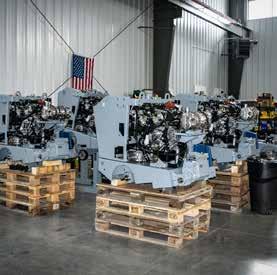

Mention manufacturing in Saratoga County and Global Foundries is often the first thing that pops into your head. While Global Foundries’ computer chips have certainly renewed the area’s reputation as a production hub within the state, they are a company building on a foundation that existed long before their arrival.
According to the National Association of Manufacturers, manufacturing is responsible for between 10 and 11 percent, or $2,390 billion, of the country’s annual gross domestic product (GDP). In New York, manufacturing employs 4.5% of the workforce and accounts for just four percent of the state’s total economic output. In 2019, chemical companies were responsible for the largest share of this total, followed by computer and electronics production.
In Saratoga County, those numbers are much higher than the state average. Manufacturing is the third largest employer (behind healthcare and education) and is estimated to make up 10% of jobs. In 2019, the Saratoga County Prosperity Index clocked manufacturing as responsible for 21% of the county’s GDP, a growth of five percent from its 2007 level.
Major manufacturing and fabrication companies have long shaped the course of Saratoga’s history. The land, and more precisely, its interconnected waterways, made this area attractive to settlers. By harnessing the power of water, industry became economically viable. Water provided transportation and power to fuel the milling of grains, and in the time before freezers, harvesting ice was incredibly important. Before the Revolutionary War, logging and paper mills took advantage of these natural resources and were very successful. The factories brought an economic prosperity that allowed other smaller businesses to establish themselves as well.
Today, paper and printing are the ninth largest manufacturing sector in the state. When stiff competition and unsustainable business practices forced other paper mills to shut their doors or move elsewhere, Cottrell Paper remained, as did the continued importance of the industry to this region.
Like its manufacturing counterparts, Cottrell Paper relies on an abundant water supply.
“Water is the key to making paper,” said Ben Cottrell. In 1926, his great-grandfather, and his two sons, Frank, and Jim, each contributed $500 towards the $1,500 used to purchase the Rock City Falls building where the Cottrell family is still making paper today.

Cottrell Paper is a family-owned and operated business that makes the electrical insulating and specialty papers used in almost every household appliance, as well as motors and transformers. The process for making these papers is very different than the one used to make notebook or toilet paper.
Insulating papers are produced at a rate of just 100 feet/minute (compared to the 10,000 feet/minute that a tissue manufacturer churns out).
Nevertheless, when other area paper mills disappeared, Cottrell Paper was able to step-in and fill the void.
This is due, in a large part, to their willingness to reinvest in their operation.
“Many of the smaller companies disappeared because they did not put their resources back into their equipment. That’s the opposite of our philosophy and that’s how you get to produce paper for 96 years,” said Cottrell.
Cottrell Paper invests between $500,000 and $1 million annually in capital improvement projects (that’s as much as 12.5% of their annual $8 million in revenue).
When the pandemic slowed orders, Cottrell Paper used the downtime to create a unique new product. In 2021, they became the only company in the country to produce a 100% hemp paper.
“People were looking for a more sustainable product so we started experimenting,” said Cottrell.
In 20 years, one acre of hemp can produce as much as four to ten acres of trees without the use of herbicides and pesticides.
However, because hemp holds in a lot of moisture, most other hemp products contain an average of 75% wood pulp. Creating papers that are 100% hemp was a challenge that took considerable time and trial-and-error but today, Cottrell Paper has succeeded where others weren’t able to and are making a sustainable hemp packaging product with good insulating properties.
Sustainability is embedded into the way Cottrell Paper does business. They use between 200 – 250,000 gallons of water per day from the Kayaderosseras Creek and take responsibility for maintaining this essential shared community resource very seriously.

“What we take in, we send back out,” said Cottrell, about their usage (which results in water that’s more chemically pure being returned to the river than when it was drawn in).
In a procedure that is regulated by the NYDEC, sand filters even the muddiest waters from the river, creating a pristine liquid at an optimum 7.0 PH for processing. After manufacturing, the remains of the cotton used to make Cottrell papers is completely scraped off, captured, and composted. The newly clarified water is then pumped out completely clear. When conditions are favorable, Cottrell Paper’s two hydroelectric turbines yield up to 500 kilowatts of power from the current.
“We’re not some big conglomerate corporation, we’re run by a family that cares,” said Cottrell. They care about the environment and the people working for them. With 43 full-time employees, as well as part-time personnel and consultants on their payroll, safety is a priority for the plant. By offering exceptional health benefits, 401K plans, accrued paid vacation days, and profit sharing, Cottrell Paper makes their employees feel like family.
In a recent report, the New York Reserve’s Empire State Manufacturing Survey indicated that new orders and shipments plunged during the first week of August. It was the second largest monthly decline on record and the biggest drop since April 2020.
The outlook is not optimistic for the next six months, the report indicated, citing a weakening domestic demand, high inflation, and rising interest rates as constraints on the industry.
Despite this bleak prediction for the state, the LISSMAC Corporation, whose US headquarters are located in Mechanicville, is experiencing record highs.

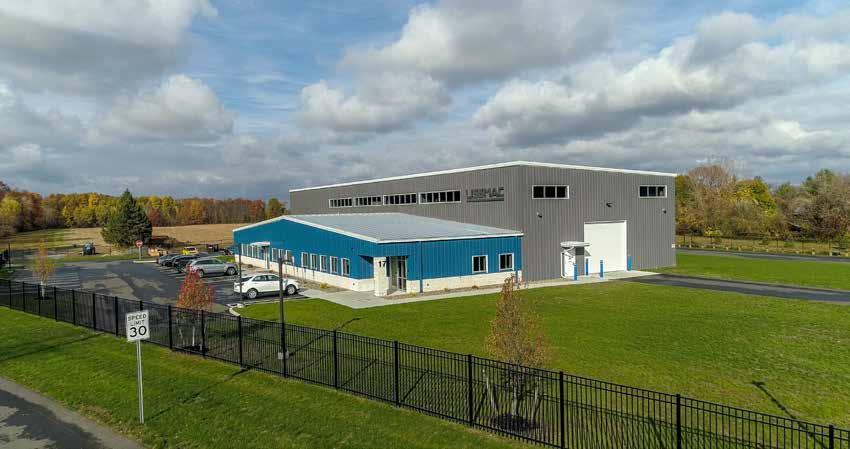
LISSMAC is a German-based company that started building metal finishing equipment and construction machinery in 1980. Vice President Ingo Heiland has been with them since October 2011, when they had just two employees working in the States. Today LISSMAC employs 22 at their 22,500 sq. ft. facility which earns an annual revenue of $12.5 million. Of that, they typically spend between $300 - $400,000 locally on components and consumables.
“In 2021we had a record year, and 2022 looks very, very promising,” said Heiland, whose confidence comes from a future that’s all about innovation.
“We produce machines that eliminate manpower and manual operations. The cost of labor has increased so much and its difficult to get people so there’s an increasing demand for our machines,” he said.
The power of being at the forefront of this societal shift is evident by the challenges LISSMAC has overcome. In 2020, the pandemic made travel difficult for their service representatives. Supply chain issues made the cost of transferring their machines back and forth to Germany increasingly expensive. The cost of shipping containers (when they were available) more than doubled from between five and six thousand dollars to as much as $15,000 each. Finding components also became challenging and costs rose to five times as much as they’d previously been.
Although their products are quite high-tech, LISSMAC’s jobs are still approachable to enter into for the mechanically-inclined worker. LISSMAC prefers to do all their training in-house and offers attractive benefit packages that include 100% health insurance coverage, life and short-term disability coverage. They strive for a family atmosphere in the workplace and give employees 10 paid holidays each year. Service techs earn extra perks including airline miles and hotel points.
Moving into the future also means being environmentallyconscious in the world’s changing climate.
“I’m of European heritage,” said Heiland, “so I always like the environmentally and economically conscious version of things.” He recently purchased a fully-electric company car, strives to use a minimum amount of paper in the office and has installed LED lighting throughout their building. In the future, they hope to expand, at which time he’d like to install a solar photovoltaic roof.
Wire EDM, turning, milling, and grinding of parts for the defense, education, energy, medical, and transportation industries.
AGROCHEM USA
Chemicals for the dairy, brewery, and laundry industries.
APPLIED MATERIALS
Semiconductor, solar, and automated display equipment.
ARCLAY NATURAL TECHNOLOGIES
Extraction of minerals from clay.
ASTROCHEMICAL
Adhesives, sealants, coatings, encapsulants, composites, saturants, and specialty chemicals.
BALL
Metal containers for beverage, personal care, and household products.
BIOSAN
Disinfectants and sanitation solutions for agriculture, brewing, oil and gas, wastewater treatment and other industries.
BOBRICK
Washroom accessories and toilet partitions.
CASCADES TISSUE GROUP
Packaging and tissue products.
CBM FABRICATIONS
Metal and plastic parts and assemblies.
COTTRELL PAPER COMPANY
Electrical insulation and specialty papers.

ESPEY INC.
Military and industrial power supplies and transformers.
EVONIK
Custom chemicals for various industrial and consumer markets.
FILTERSOURCE
Air, gas, and liquid filtration supplies.
FORT MILLER GROUP
Precast concrete, burial vaults, electrometric liners, and security gate systems.
FREEDOM MANUFACTURING
Liquid storage containers and fire shelter bags.
FREE FORM FIBERS
High performance ceramic fibers and materials.
GREENFIELD MANUFACTURING INCORPORATED
Chemicals for industrial water treatment, rubber additives, specialty coatings, and more.
GUYSON CORPORATION OF USA
Surface finishing, parts-washing, and advanced robotic machines.
LISSMAC CORP
Metal finishing machines.
MERIDIAN MANUFACTURING
Precision machined parts for use in various industries.
POLYSET
Polyurethane adhesives, foams, expansion joints and coatings.
QUAD GRAPHICS
Design, marketing, printing, and packaging.
RASP INC.
Control panels, pneumatic and component assemblies.
SCA TISSUE
Paper, pulp, packaging, and wood products.
SPECIALTY SILICONE PRODUCTS, INC.
More than 1,000 silicone compounds.
TURBINE SERVICES, LTD.
Design, engineering, and manufacturing of gas turbine parts.
WINTECH
Aluminum and uPVC/PVC windows.
ZINTER HANDLING
Cranes, heavy lifting, storage systems and clean room equipment.
Above and beyond federal law, New York State (NYS), perhaps rivaled only by the state of California, makes compliance with state law nearly a fulltime job. Compliance requirements span from Safety and the Environment to Employment and Corporate Taxes, and everything in between.
While we are not here to debate the “value vs. burden” equation of state laws on employers, we are here to shed light on just 3 of the upcoming changes to New York State (excluding New York City) Employment specific regulations (in some cases laws) you may not yet be hip to.
Speaking of frequently changing regulation, this article will not attempt to cover the NY COVID-19 related guidance, regulations, laws or the complexities associated with them.

The New York State legislature passed a bill in April 2022 requiring employers to make mandatory workplace postings electronically available for their employees. Although the bill is yet to be signed by Gov. Kathy Hochul, it is expected to be effective immediately upon execution.
NYS Labor Law Section 201 currently mandates that New York employers post certain legal notices provided by the commissioner of labor in a conspicuous place on each floor of the workplace. However, The electronic posting requirement will apply to all documents required to be posted at a worksite under state and federal law or regulation, not just under the labor law.
All New York employers must soon:
Compile or make digital copies of these postings and upload them to their company intranet. If the company does not have an internal website, it should draft an e-mail with the postings attached for dissemination to employees.
Regardless of the method used to share these digital copies (intranet or e-mail), the employer must also provide employees with notice that the documents are available electronically.

3
Employers are also encouraged to update internal job descriptions, work instructions, handbooks, etc. to help ensure continued management of, and compliance with this new electronic posting and notification requirement in the years to follow as both required postings and their employee base change.


In October 2021, Gov. Kathy Hochul signed into law a requirement for private employers to automatically enroll all employees in the state-run retirement savings program.
Although it is unclear when the state-run program will open for enrollment, employers that do not already sponsor their own retirement plans will soon be required to automatically enroll employees in New York’s state-run savings plan.
Employer participation in the program is mandatory for both nonprofit and for-profit employers operating:
In the state of New York for more than 2-years
With 10 or more employees (full and/or part-time) in New York State
Without already offering those employees a qualified retirement plan
A recent proposal in the NY Senate (bill S3062C) & Assembly (bill A7503B) will tie the NYS minimum wage to the combination of the consumer price index (CPI) and a measure of labor productivity. The proposed change is thought to lift minimum wage for 2 million New York workers, to between $16.35 and $21.25 by 2026.
In support of this proposal, NYS has designated three different regions of the state: New York City, the suburban counties of Nassau, Suffolk, and Westchester, and the remainder of upstate New York. Under current projections for inflation and labor productivity increases are expected as follows:
• New York City’s minimum wage would rise from $15 to $21.25
• Nassau, Suffolk, and Westchester counties’ minimum wage would rise from $15.00 to $18.65
• Upstate New York would rise from $13.20 to $16.35
All information
HR
above
just like yours through complex change with its remarkable ability to tailor decades of past startup and Fortune
-
 WRITTEN BY TYLER A. MCNEIL | PHOTOS PROVIDED
WRITTEN BY TYLER A. MCNEIL | PHOTOS PROVIDED
Seasoned digital gaming entrepreneur Brian Corrigan remembers working unpaid shifts as long as 75 hours a week in his upstairs bedroom, worrying about compensating his two employees after blowing all his start-up funds in three months.


It didn’t fail. Saratoga Springs-based Madglory — credited for widening the Capital Region digital gaming cluster’s talent pool — was acquired in a multi-million-dollar deal by a Korean firm to provide back-end support for PlayerUnknown’s Battlegrounds.
But with his latest venture, Corrigan believes he’s starting off on a better foot this time.
“What we’re doing differently is that we have a very clearly developed five-year vision of where we want to be and the type of company we want to work for,” Corrigan said. “At some point, it’s not about survival. It’s about how you want to thrive.”
The 43-year-old entrepreneur in May co-founded Rocket Science Corporation with self-described “chief propulsionist” Tom Daniels, a former executive for BD Gaming in Austin, Texas.
Now headquartered in the Halfmoon hamlet of Crescent, the duo plans to establish a second location in Daniels’ hometown, Cardiff, Wales, and possibly a third in Austin. Having a Cardiff site, they hope, will position Rocket Science to build a game development community from the area’s tech talent pool while closer to European markets.
Rocket Science five years forward hopes to fill 100 onsite, hybrid, and remote positions. Corrigan plans for at least half of the company’s workforce based in the Capital Region.

Currently leasing an inconspicuous Crescent-Vischer Ferry Road office, he aims to eventually shift local operations to a former firehouse in East Glenville. The site cost $350,000 overall.

Some $1.4 million from Empire State Development is expected to help cover workforce development and equipment costs, as well as establish a business incubator for digital gaming start-ups in coordination with the Tech Valley Game Space. Adirondack Trust Co. is also financing some of the renovation expenses.
Corrigan plans to lease out the southern-wing as restaurant space.
“Ultimately, it’s because I just want to have a nice coffee shop next to my office,” Corrigan said.
Rocket Science is one of several emerging firms with major industry ambitions, including Velan Studios, Rushdown Studios, Jahnel Group, and Wolfjaw Studios. The Capital Region’s so-called digital gaming cluster total boasted 16% growth last year, the Center for Economic Growth reported in March.
Providing venture capital and expertise, Corrigan is still involved with a number of ex-Madglory associatesturned-entrepreneurs. Between his and Daniel’s connections, Corrigan maintained that the duo knows “somebody everywhere.”

“If we’re competing for anything, we’re probably competing for culture as a region,” Corrigan said. “It’s really to make this cluster work and that’s a team game.”
Corrigan attempted to take a break from the industry last March, spontaneously resigning as Vice President of the Americas for now-KRAFTON-owned PUBG. Choosing to exit the job as an international executive was anxietywrenching, the serial entrepreneur maintained.
“Sometimes I’d wake up in cold sweats like, ‘what the — what is — what are you doing?’” Corrigan said.
On hiatus for about a week, Corrigan pursued a project for California-based Super Evil Megacorp studio betwixt cofounding Rocket Science.
Corrigan started working in the cluster 14 years ago as chief technology officer for Agora Games. The Clarkson University graduate previously provided back-end development support services for more than 13,000 slot machines with state lottery contractor now-Everi Holdings.

Today it is close to impossible for most people to imagine that Saratoga Springs has ever been anything other than a crown jewel. Not just in Upstate NY but regionally and even nationally.
Almost two hundred years of Health, History and Horses –romanticized and true – cap the mystique of the “city in the country,” but managing that glowing brand has required enormous effort on the part of a great many people over years. It has required vision and risk, investment and experimentation. And all of that has rested on a foundation of belief in, and dedication to the city of Saratoga Springs.
One of the most visible and important examples of that is the Saratoga Springs City Center which, along with its companion hotel, sits at the north end of Broadway.
Few today can imagine the distress that longtime Saratogians – many returning veterans of WW2 – felt when they assessed the state of the city in the mid-twentieth century. The few grand
hotels that helped put Saratoga on the map in the nineteenth century were in shambles as was most of the city. “There had been no racing for three years due to the war, businesses had failed, and it seemed to my father and his generation that Saratoga was dying,” said Charles Wait – who succeeded his father as chairman of the Adirondack Trust bank and himself became a leader in the rebirth efforts. “Things had become so dire that NYRA was seriously considering closing its Saratoga operations in favor of Downstate tracks. It took the resolve of old racing families to keep our historic track open,” said Wait.
Plagued by deteriorating infrastructure, an eroding business base, crime and illicit gambling Saratoga Springs had become a town that many wanted to avoid, so much so that even some prominent families relocated north and east of the downtown area.
In 1965 the 72-year-old Convention Hall – on the south of Congress Park with a seating capacity of 5000 – burned to the ground. What could have been a nail in the coffin became a call to action.
It took decades of resolve, planning, and arduous execution – in stages – to get the city on the trajectory that has earned pages of accolades ranging from Best Small City in NY to Best Main Street in the USA to inclusion in “Five hideaways that aren’t the Hamptons.” The list goes on from the serious to the comical: Healthiest Community in NYS and “most bars per person.”
A veritable Who’s Who of prominent local families – generations of local families – rose to address what they saw as a “swim or sink” challenge that would span urban renewal, historic preservation, revitalization of downtown, and benefits to the larger region. This would require great funding, state and federal support, and the buy-in of the citizenry. Wait colorfully recalls the many attempts to coalesce public support and secure funding from the proverbial cloakroom arm twisting to the participation of thousands in civic pride projects. “In many different ways, many different people supported the kind of groundswell that was necessary to achieve Saratoga Springs‘ rebirth,” he said.
“What seemed to be a very risky venture has turned out to be the foundation for the prosperity we enjoy today.”
Though a number of other important constituent supporting steps had been taken in the 1950s, many cite the communitybased creation of Saratoga Springs Community Hotel, Inc. in 1961 as a high profile turning point. This effort created the Holiday Inn on South Broadway and was the beginning of – and a pioneering reason for – Saratoga’s return, albeit in an updated and sustainable way, to destination status.
Promising vital signs - community involvement, support of outside agencies, the creation of SPAC and the relocation of Skidmore to North Broadway – gave civic boosters reason for optimism but the situation was by no means secure. A Plan of Action was created with the goal of making Saratoga Springs the Year Round Place to Be. Essential to the success of that ambitious goal would be creating a reason for people to come to Saratoga all year long.
In July 1983 the SSCC Authority – a so-called public benefit corporation – was formed to oversee pre- and post-construction management of the center. As an “authority” it would have more freedom to operate. Utilizing insurance money from the old Convention Hall fire – $800,000 which had been accruing interest over two decades – and creating a new resource channel through a one percent increase in local sales tax, the planning and construction for this new facility began. When completed the City Center would add 37,000 square feet of space and seat as many as 2,500 people, thus filling what had been a 20-year handicap for the Spa City.
According to City Center director Ryan McMahon, the venue typically hosts over 160 events close to 300 days a year with NYS associations, trade shows, union meetings, and corporate business forming the “bread and butter” of Center activity. But it’s a community resource as well as varied cultural showcase. After 28 successful years it had become increasingly clear that, in order to sustain that trajectory, an expansion of the City Center was necessary.
When asked why he helped secure $12M in state funding to support expanding the City Center, the late Senator Joe Bruno, a champion of the region, replied “Why the City Center? Because Saratoga Springs competes with the whole world as a destination. When you expand a facility like this you open your market up.”
In 2011 the expansion and “refresh” was completed, adding 12,000 square feet of space (58,000 square feet of space when the City Center is combined with the connected Saratoga Hilton). Along with the 2019 completion of a multi-level attached parking facility with over 600 spaces, both Discover Saratoga and City Center staff found that several groups that had outgrown the old facility were able to return. In addition, new groups had been attracted.

Since the early ‘80s City Center guests have created potential sales of $470M, which has generated more than $33M in sales tax revenue. The City Center has generated $321M in sales that are subject to city, county and state sales tax. “It’s not only an enviable economic engine,” says Center director Ryan McMahon, “but the very high satisfaction levels visitors report get shared when they return home, creating priceless word of mouth endorsements.”
Regarding the importance of the City Center, Saratoga County Chamber of Commerce President Todd Shimkus quoted a chamber publication, Saratoga Springs –Transformation by the Passion of a Community. “This publication tells the story of the city’s revitalization and includes the creation of the City Center,” he said. “The story begins: ‘Many consider the opening of the City Center in the summer of 1984 to be one of the most important achievements in the rebirth of Saratoga Springs. Without it, Saratoga would not have the substantial convention business that has strengthened the city’s economy.’”
Discover Saratoga’s president Darryl Leggieri agrees: “The City Center is such an important part of our local economy and has made all the difference in supporting Saratoga as a year-round destination; it brings thousands of visitors to town each year who stay in our hotels, eat in our restaurants, and shop in our boutiques. Having the Center surrounded by a safe, walkable, and vibrant downtown gives us a tremendous advantage when selling Saratoga. This strengthens the local economy for all, which continues to strengthen the Saratoga Brand. It’s a win-win.”
The years of Covid hit the Center’s bottom line hard. “In 2019 the SSCC’s earned revenue was just over $1.1 million. There has clearly been a drop with COVID so 2021 was only $430,000.

In 2022 we are getting back on track. Even after a first quarter with almost no events revenue will be over $900,000” McMahon explained. But McMahon and his team were not idle when the Center was offline: “we were able to take advantage of our status as a state authority to complete the much-needed parking facility when most other projects were halted and it gave us an opportunity to increase our collaboration with Discover Saratoga, the Chamber, the Downtown Business Association, and others.” This all contributed to the speedy rebound that McMahon’s numbers reflect. “We showed a macro economic impact on the area of $40M in 2019. That dropped to $15M last year but we are well on the way to reaching new highs,” he said.
“Some very forward thinking people worked hard to create the SSCC in the 80’s which was one of the keys to Saratoga Springs current success. It is a symbiotic relationship where the SSCC helps to support the downtown business community and the presence of a vibrant downtown makes the SSCC a more desirable venue. This allows us to punch out of our weight class,” McMahon says with pride.
Echoing the interdependency of the local marquee elements –SPAC, downtown, the City Center, and Skidmore College – the view expressed by all is that Saratoga Springs sells itself.
The “city in the country” has a diverse portfolio of offerings, attracting diverse audiences generating hundreds of millions of dollars to both the city and region. So, if you have a moment of frustration trying to navigate Broadway, whether it’s summer’s race season or winter’s Chowderfest, we’ve become The Year-Round Place to Be!

